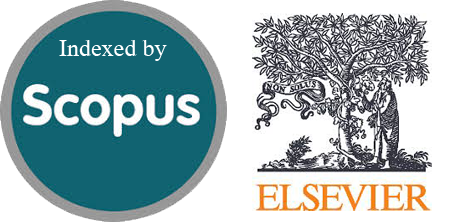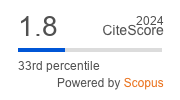Comparison of Machine Learning Algorithms in Detecting Tea Leaf Diseases
Abstract
Tea is one of the top ten export products sent from Indonesia to foreign countries. However, in recent years, the amount of tea leaf exports from Indonesia has decreased, although the value of the export impacts the country’s economic structure. In addition to market competition, Indonesia must maintain tea leaf production so that the increase in export decline is not significant or even increases tea leaf export production. To improve production quality and reduce production costs, early detection of tea leaf diseases is necessary. This study aims to classify tea leaf images for early detection of tea leaf disease so that appropriate treatment can be carried out early. This study compares machine learning algorithms to determine the best algorithm for detecting tea leaf diseases. The algorithms tested as performance comparisons in classifying tea leaf diseases are random forest (RF), support vector classifier (SVC), extra tree classifier (ETC), decision tree (DT), XGBoost classifier (XGB), and convolutional neural algorithms. Network (CNN). As a result, the average accuracy performance generated by ETC produces a higher value than other algorithms, i.e., getting an average accuracy performance of 77.47%. Another algorithm, SVC, has an average accuracy of 76.57%, RF of 76.12%, DT of 65.31%, XGB of 71.62%, and the lowest is CNN of 59.08%. ETC has been proven to be the most superior machine learning algorithm for detecting tea leaf diseases in this study.
Downloads
References
S. Salsabila, I. Rahmiyani, and D. Sri Zustika, “Nilai Sun Protection Factor (SPF) pada Sediaan Lotion Ekstrak Etanol Daun Jambu Air (Syzygium aqueum),” Majalah Farmasetika, vol. 6, no. Suppl 1, p. 123, 2021, doi: 10.24198/mfarmasetika.v6i0.36664.
Q. Ayun, S. Kurniawan, and W. A. Saputro, “Perkembangan Konversi Lahan Pertanian Di Bagian Negara Agraris,” Vigor: Jurnal Ilmu Pertanian Tropika Dan Subtropika, vol. 5, no. 2, pp. 38–44, 2020, doi: 10.31002/vigor.v5i2.3040.
Subdirektorat Statistik Ekspor, BULETIN STATISTIK PERDAGANGAN LUAR NEGERI, Desember. Jakarta: BPS RI, 2020.
H. Nursodik, S. Imam Santoso, and S. Nurfadillah, “Competitiveness of Indonesian Tea Export in Southeast Asia Markets,” SOCA: Jurnal Sosial, Ekonomi Pertanian, vol. 16, no. 1, p. 1, 2022, doi: 10.24843/soca.2022.v16.i01.p01.
Y. Sari and S. W. Meisari, “Alat Penyortir Warna Daun Teh Menggunakan Sensor Tcs3200 Berbasis Raspberry Pi Dan Arduino,” Tekinfo, vol. 22, no. 1, pp. 117–130, 2021.
M. I. Sadikin, T. Swandari, and F. Wilisiani, “Membangun Sinergi antar Perguruan Tinggi dan Industri Pertanian dalam Rangka Implementasi Merdeka Belajar Kampus Merdeka,” Seminar Nasional dalam Rangka Dies Natalis ke-45 UNS Tahun 2021, vol. 5, no. 1, pp. 245–252, 2021.
M. I. Prawira-Atmaja et al., “Evaluasi Kesesuaian Mutu Produk Teh Dengan Persyaratan Standar Nasional Indonesia,” Jurnal Standardisasi, vol. 23, no. 1, p. 43, 2021, doi: 10.31153/js.v23i1.845.
S. D. S. T. Perkebunan, STATISTIK TEH INDONESIA 2021, no. 1. Jakarta: BPS RI, 2021.
L. Q. Aini, “Efektivitas Tribasik Tembaga Sulfate (93%) Terhadap Penyakit Cacar Daun Exobasidium vexans Pada Tanaman Teh,” Jurnal Sumberdaya Alam dan Lingkungan, vol. 9, no. 2, pp. 76–81, 2022, doi: 10.21776/ub.jsal.2022.009.02.5.
J. Chen, Q. Liu, and L. Gao, “Visual tea leaf disease recognition using a convolutional neural network model,” Symmetry, vol. 11, no. 3, 2019, doi: 10.3390/sym11030343.
Saeful Rahmat, “PENGARUH PEMBERDAYAAN PETANI TERHADAP PENERAPAN TEKNOLOGI BUDIDAYA SERTA IMPLIKASINYA PADA PRODUKTIVITAS KEBUN TEH RAKYAT (Camellia sinensis),” Repository Universitas Winaya Mukti, 2020.
H. Orchi, M. Sadik, and M. Khaldoun, “On using artificial intelligence and the internet of things for crop disease detection: A contemporary survey,” Agriculture (Switzerland), vol. 12, no. 1, 2022, doi: 10.3390/agriculture12010009.
A. V. Panchal, S. C. Patel, K. Bagyalakshmi, P. Kumar, I. R. Khan, and M. Soni, “Image-based Plant Diseases Detection using Deep Learning,” Materials Today: Proceedings, no. September, 2022, doi: 10.1016/j.matpr.2021.07.281.
T. Domingues, T. Brandão, and J. C. Ferreira, “Machine Learning for Detection and Prediction of Crop Diseases and Pests: A Comprehensive Survey,” Agriculture (Switzerland), vol. 12, no. 9, pp. 1–23, 2022, doi: 10.3390/agriculture12091350.
W. Wu, “Identification of tea leaf diseases based on deep transfer learning,” vol. 2, no. 3, pp. 3–5, 2022.
J. Chen and J. Jia, “Automatic Recognition of Tea Diseases Based on Deep Learning,” in Advances in Forest Management under Global Change, vol. 11, no. tourism, IntechOpen, 2020, p. 13. doi: 10.5772/intechopen.91953.
G. Hu, H. Wang, Y. Zhang, and M. Wan, “Detection and severity analysis of tea leaf blight based on deep learning,” Computers & Electrical Engineering, vol. 90, p. 107023, Mar. 2021, doi: 10.1016/j.compeleceng.2021.107023.
G. Hu, X. Yang, Y. Zhang, and M. Wan, “Identification of tea leaf diseases by using an improved deep convolutional neural network,” Sustainable Computing: Informatics and Systems, vol. 24, p. 100353, Dec. 2019, doi: 10.1016/j.suscom.2019.100353.
G. Volkmar, P. M. Fischer, and S. Reinecke, “Artificial Intelligence and Machine Learning: Exploring drivers, barriers, and future developments in marketing management,” Journal of Business Research, vol. 149, no. April 2021, pp. 599–614, 2022, doi: 10.1016/j.jbusres.2022.04.007.
W. Bao, T. Fan, G. Hu, D. Liang, and H. Li, “Detection and identification of tea leaf diseases based on AX-RetinaNet,” Sci Rep, vol. 12, no. 1, pp. 1–16, 2022, doi: 10.1038/s41598-022-06181-z.
M. G. Lanjewar and K. G. Panchbhai, “Convolutional neural network based tea leaf disease prediction system on smartphone using paas cloud,” Neural Comput Appl, vol. 35, no. 3, pp. 2755–2771, Jan. 2023, doi: 10.1007/s00521-022-07743-y.
X. Zou, Q. Ren, H. Cao, Y. Qian, and S. Zhang, “Identification of tea diseases based on spectral reflectance and machine learning,” Journal of Information Processing Systems, vol. 16, no. 2, pp. 435–446, 2020, doi: 10.3745/JIPS.02.0133.
S. Mukhopadhyay, M. Paul, R. Pal, and D. De, “Tea leaf disease detection using multi-objective image segmentation,” Multimedia Tools and Applications, vol. 80, no. 1, pp. 753–771, Jan. 2021, doi: 10.1007/s11042-020-09567-1.
S. Meng, S. Wang, T. Zhou, and J. Shen, “Identification of Tea Red Leaf Spot and Tea Red Scab Based on Hybrid Feature Optimization,” Journal of Physics: Conference Series, vol. 1486, no. 5, 2020, doi: 10.1088/1742-6596/1486/5/052023.
A. I. Champa, Md. F. Rabbi, S. M. Mahedy Hasan, A. Zaman, and Md. H. Kabir, “Tree-Based Classifier for Hyperspectral Image Classification via Hybrid Technique of Feature Reduction,” in 2021 International Conference on Information and Communication Technology for Sustainable Development (ICICT4SD), IEEE, Feb. 2021, pp. 115–119. doi: 10.1109/ICICT4SD50815.2021.9396809.
J. A. Pandian, S. N. Nisha, K. Kanchanadevi, A. K. Pandey, and S. K. Rima, “Grey Blight Disease Detection on Tea Leaves Using Improved Deep Convolutional Neural Network,” Computational Intelligence and Neuroscience, vol. 2023, pp. 1–11, 2023, doi: 10.1155/2023/7876302.
R. T. Tedjo, A. M. Sambul, and A. S. M. Lumenta, “Klasifikasi Gambar Bahan Makanan untuk Penderita Buta Warna,” Jurnal Teknik Elektro dan Komputer, vol. 11, no. 2, p. 67, 2022, doi: 10.35793/jtek.11.2.2022.37794.
G. Kimutai and A. Förster, “tea sickness dataset.” Mendeley Data, p. https://data.mendeley.com/datasets/j32xdt2ff5, 2022. doi: 10.17632/j32xdt2ff5.2.
H. Pramoedyo, D. Ariyanto, and N. N. Aini, “Comparison of Random Forest and Naïve Bayes Methods for Classifying and Forecasting Soil Texture in the Area Around Das Kalikonto, East Java,” BAREKENG: Jurnal Ilmu Matematika dan Terapan, vol. 16, no. 4, pp. 1411–1422, 2022, doi: 10.30598/barekengvol16iss4pp1411-1422.
A. Surya, “Machine Learning and Ensemble Approach Onto Predicting Heart Disease,” pp. 1–7, Nov. 2021.
suwarno and R. Kusnadi, “Analisis Perbandingan SVM, XGBoost dan Neural Network pada Klasifikasi,” Jurnal RESTI (Rekayasa Sistem dan Teknologi Informasi), vol. 5, no. 5, pp. 896–903, Oct. 2021, doi: 10.29207/resti.v5i5.3506.
C. N. Ihsan, “Klasifikasi Data Radar Menggunakan Algoritma Convolutional Neural Network (CNN),” DoubleClick: Journal of Computer and Information Technology, vol. 4, no. 2, p. 115, 2021, doi: 10.25273/doubleclick.v4i2.8188.
N. Agustina, Adrian, and M. Hermawati, “Implementasi Algoritma Naïve Bayes Classifier untuk Mendeteksi Berita Palsu pada Sosial Media,” vol. 14, no. 4, pp. 1979–276, 2021, doi: 10.30998/faktorexacta.v14i4.11259.
Copyright (c) 2024 Jurnal RESTI (Rekayasa Sistem dan Teknologi Informasi)

This work is licensed under a Creative Commons Attribution 4.0 International License.
Copyright in each article belongs to the author
- The author acknowledges that the RESTI Journal (System Engineering and Information Technology) is the first publisher to publish with a license Creative Commons Attribution 4.0 International License.
- Authors can enter writing separately, arrange the non-exclusive distribution of manuscripts that have been published in this journal into other versions (eg sent to the author's institutional repository, publication in a book, etc.), by acknowledging that the manuscript has been published for the first time in the RESTI (Rekayasa Sistem dan Teknologi Informasi) journal ;








